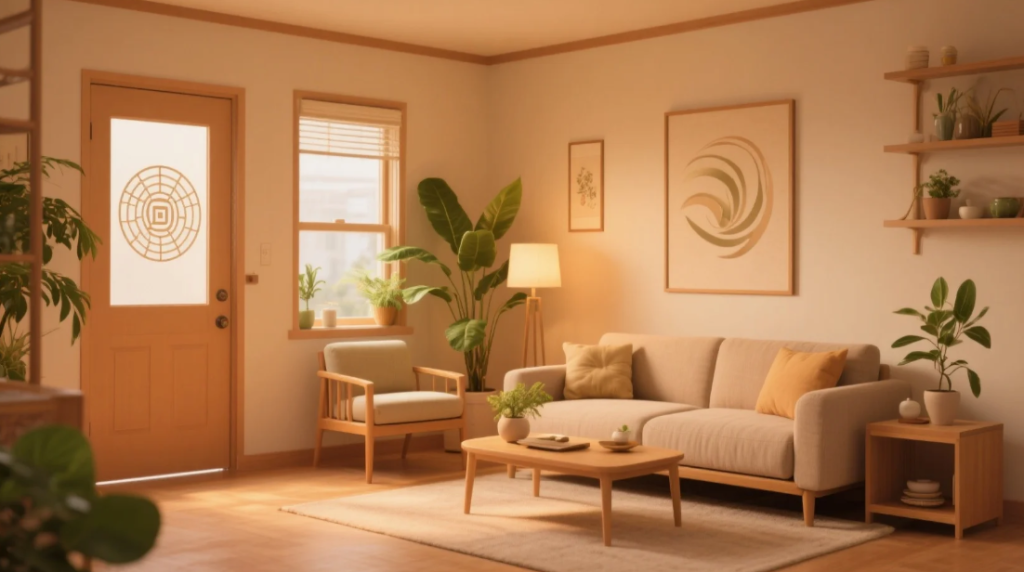Do you struggle fitting everything in a cozy living room that spills right from the front door? A smart front door feng shui small living room layout can solve that. With intentional arrangement, even limited space can feel open, harmonious, and energetically uplifting.

Why Front Door Layout Matters in Small Spaces
Ever felt rushed the moment you step in? In small rooms, the front door often clashes with sofa placement or TV zones. In feng shui, front-door area is critical because it welcomes energy, also known as Chi. If blocked or cluttered, vital energy can stall.
For example, Jenny placed her couch right behind the entrance. She felt rushed and unsettled. After moving it and creating an open path, her home suddenly felt calmer. However, worth noting, even a few inches of clearance can shift energy drastically.
Common Challenges in Small Living Rooms
What issues do small living rooms face? First, lack of clear pathways. Energy gets stuck between walls and furniture. Second, improper seating orientation—people sit with back to door, feeling vulnerable. Third, TV placement often blocks beneficial light or window flow.
The challenge is real. But good news: thoughtful layout tweaks can change the vibe completely.
Smart Space-Saving Furniture Tips
How do you arrange furniture smartly?
- Choose low-profile sofas or benches that don’t block energy flow.
- Use multi-functional pieces like storage ottomans.
- Add a narrow table behind your sofa for keys and mail.
- Position seating in a semi-circle to foster connection and openness.
A clever solution: use floating shelves instead of bulky cabinets. This keeps Chi gliding along walls, not bumping into objects. For example, Mark swapped his heavy console for wall shelves. His space looked bigger and felt more balanced.
Feng Shui Seating and Command Position
In feng shui, the command position means you face the front door while seated, without being in direct line with it. Even angle seating at 30 degrees can achieve this.
Take Emily: she angled her loveseat so it faced the door diagonally. She said it instantly felt more secure. However, interestingly, she avoided placing it right opposite the door to prevent energy rushing straight at her.
This layout supports relaxation, social connection, and serenity.
Enhancing Energy Flow with Add-Ons
Small touches can amplify flow:
- Use a small area rug to define seating zones—Chi loves structure.
- Include a mirror opposite the entrance to reflect light.
- Add a plant near the door to slow strong inbound energy.
- Opt for round or oval coffee tables to soften corners and promote movement.
For instance, Tom added a fiddle-leaf fig next to his front door. It buffered abrupt energy and improved his focus on arriving home. An easy but effective adjustment.
Real-Life Case Study: Balance in a Compact Home
Let’s look at Chris’s story. He lived in a studio where the door opened onto the couch. He felt anxious and clutter built quickly.
He used a layout plan to shift the seating diagonally. Then he added floating shelves and a mirror. Within weeks, he noticed improved relaxation and better sleep.
Interestingly, he also painted the entrance wall a soft green to promote calming wood energy. This multi-layered approach created a surprisingly spacious feel.
Common Mistakes to Avoid
Be careful not to make these errors:
- Blocking door sight-line: Don’t place tall furniture directly opposite the entrance.
- Overstuffing with décor: Too many accents create stagnation.
- Ignoring natural light: Keep curtains minimal to let Chi in.
- Neglecting pathway widths: Leave at least 24 inches for walking flow.
For example, by removing a heavy cabinet opposite the door, Lisa opened her space both visually and energetically.
Final Tips and Takeaways
A well-designed front door feng shui small living room layout combines good dimensions with intentional placement. Measure carefully, choose light furniture, create clear pathways, and add balancing accessories. Over time, this improves how your home feels and how you feel living in it.
